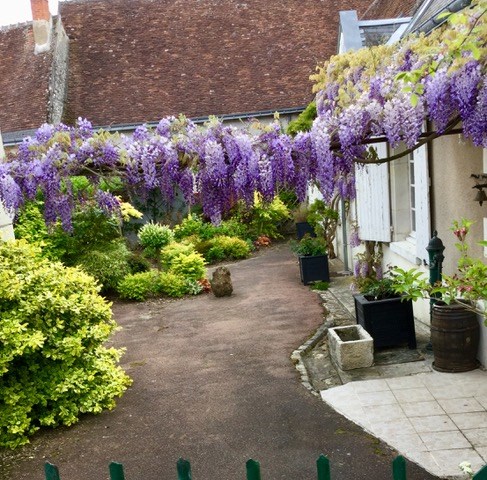Oo la la! Hubby and I just returned from a week in the Loire Valley visiting our friends in their little village of Larcay, just outside of Tours.
We have never experienced any other areas in France outside of Paris so this was a real treat! Our friends focused on showing us the highlights of the area such as visiting the many castles, limestone caves dotted throughout the valley, historic towns, architecture and wines. In 2000, UNESCO added the central part of the Loire River Valley to its list of World Heritage Sites.
Our friends also made sure that every day on our many adventures, beautiful gardens were included.
The Loire Valley is about 2 weeks ahead of our growing season. Fragrant lilacs and wisteria are blooming in full splendour. Imagine walking through an ancient little village (once even occupied by the Romans) with dripping wisteria all around you and lilacs growing out of walls of castles.
There was another floral delight that we grow here in Richmond but do not pay much attention to. In fact, we view it most times as a bother because of it’s spreading nature. Markets were pushing little nosegays of lily of the valley (muguet, en francais). You found yourself breathing deeply with all of the floral perfumes in the air.
There is an abundance of lily of the valley bouquets in the area which are included as part of their May 1st festival, Fete du Muguet. The French spent over $47 million CAD last year to buy lily of the valley as a token of affection for family and loved ones.
We were astounded by the lushness of the lilac shrubs in the Loire Valley. Many of our lilacs here in Richmond tend to be less shrub and more tree-like.
To achieve turning your lilacs back into a shrub, pruning is the key. There are three ways to approach this.
The drastic one year approach
After your lilac finishes blooming, prune all major branches down to within one foot of the ground. Small branches coming directly out of the ground which are less than an inch in diameter can remain. Leave all sprouts which in the immediate vicinity of the base of the shrub. Remove any sprouts outside of the base area.
One month after the original pruning shorten new growth by one half. This will cause branching so that you will get a full shrub at the base. After two months, any growth that reaches more than four feet in height should be shortened again to approximately four feet. Do not shorten branches to the exact same height as some variation looks more natural. You will not get any flowers the year following this drastic approach.
The three year approach
Prune one third of major branches to within a foot of the ground. If you have five or six major branches, prune two on different sides. The next year you will again prune one third of the major branches and the following year the same. Leave all sprouts which are in the immediate vicinity of the shrub base. Sprouts outside of this area can be removed.
Shorten all the remaining major branches to a height of four to five feet. All rapidly growing branches which reach more than 6 feet should be shortened to 6 feet during the summer.
You will have fewer flowers next spring, but the lilacs will be at a height where you can enjoy them more.
Long term approach
Prune a single major branch to within one foot of the ground. Do this every year in June until all major branches have been removed. Then follow the instructions for the three year approach.
Make sure to prune your lilacs every year in June to keep them as compact shrubs. Yearly pruning is key to keeping lilacs at a height of about six feet. Shorten all branches which reach a height of more than six feet. Shorten side branches in the upper part of the shrub so the plant is tapered in toward the top.
As we begin our major planting season in May, I will be making decisions on my pruning method for my lilacs. With a new level of respect for the lily of the valley that I already have running amok in my spring garden, I have added a lovely bouquet of the pretty little flower on our kitchen table. The perfume is stunning!



